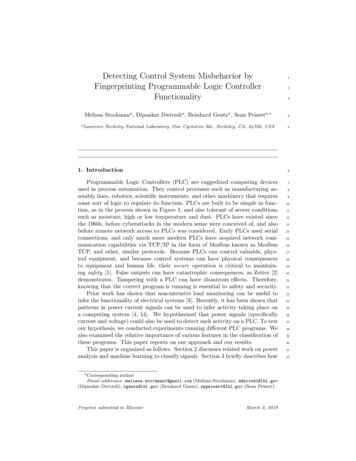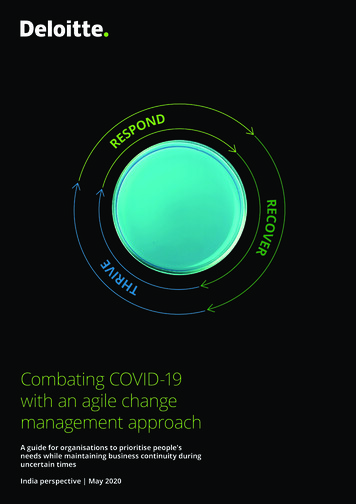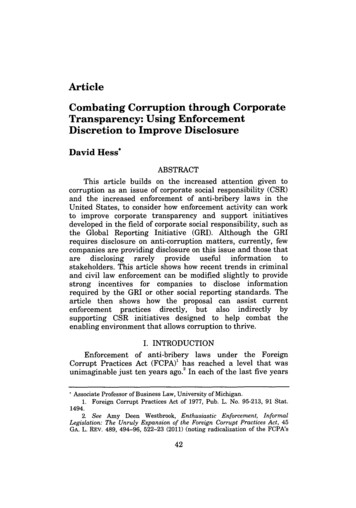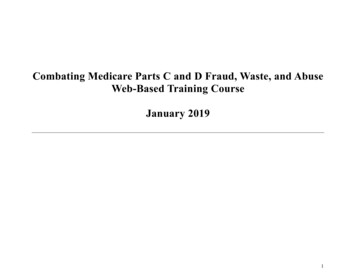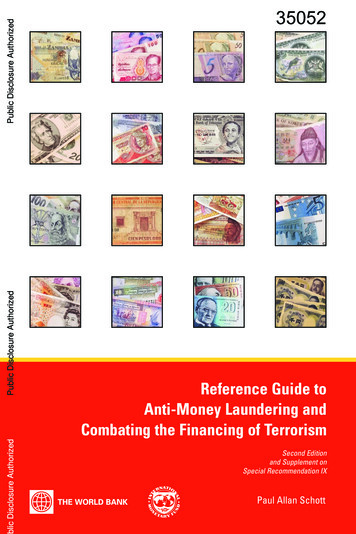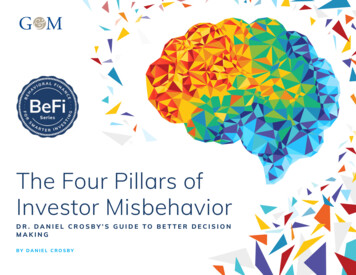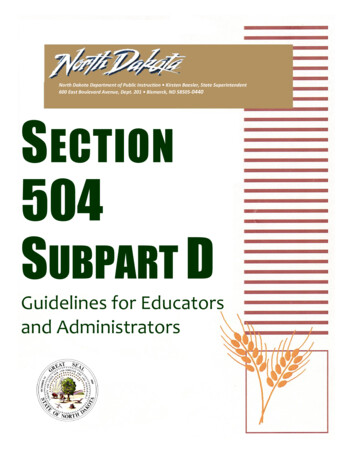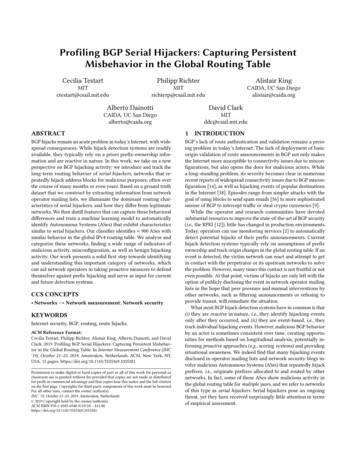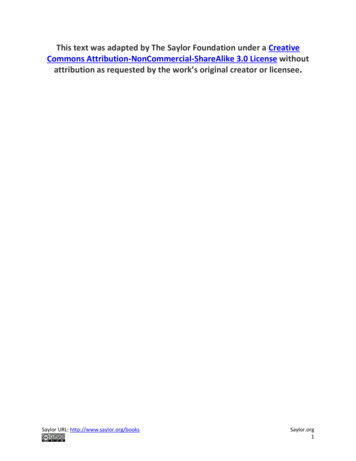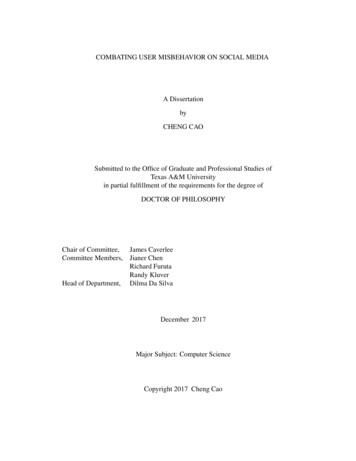
Transcription
COMBATING USER MISBEHAVIOR ON SOCIAL MEDIAA DissertationbyCHENG CAOSubmitted to the Office of Graduate and Professional Studies ofTexas A&M Universityin partial fulfillment of the requirements for the degree ofDOCTOR OF PHILOSOPHYChair of Committee, James CaverleeCommittee Members, Jianer ChenRichard FurutaRandy KluverHead of Department, Dilma Da SilvaDecember 2017Major Subject: Computer ScienceCopyright 2017 Cheng Cao
ABSTRACTSocial media encourages user participation and facilitates user’s self-expression likenever before. While enriching user behavior in a spectrum of means, many social mediaplatforms have become breeding grounds for user misbehavior. In this dissertation wefocus on understanding and combating three specific threads of user misbehaviors thatwidely exist on social media — spamming, manipulation, and distortion.First, we address the challenge of detecting spam links. Rather than rely on traditionalblacklist-based or content-based methods, we examine the behavioral factors of both whois posting the link and who is clicking on the link. The core intuition is that these behavioral signals may be more difficult to manipulate than traditional signals. We find that thispurely behavioral approach can achieve good performance for robust behavior-based spamlink detection.Next, we deal with uncovering manipulated behavior of link sharing. We propose afour-phase approach to model, identify, characterize, and classify organic and organizedgroups who engage in link sharing. The key motivating insight is that group-level behavioral signals can distinguish manipulated user groups. We find that levels of organizedbehavior vary by link type and that the proposed approach achieves good performancemeasured by commonly-used metrics.Finally, we investigate a particular distortion behavior: making bullshit (BS) statements on social media. We explore the factors impacting the perception of BS and whatleads users to ultimately perceive and call a post BS. We begin by preparing a crowdsourced collection of real social media posts that have been called BS. We then build aclassification model that can determine what posts are more likely to be called BS. Ourexperiments suggest our classifier has the potential of leveraging linguistic cues for detect-ii
ing social media posts that are likely to be called BS.We complement these three studies with a cross-cutting investigation of learning usertopical profiles, which can shed light into what subjects each user is associated with, whichcan benefit the understanding of the connection between user and misbehavior. Concretely,we propose a unified model for learning user topical profiles that simultaneously considersmultiple footprints and we show how these footprints can be embedded in a generalizedoptimization framework.Through extensive experiments on millions of real social media posts, we find ourproposed models can effectively combat user misbehavior on social media.iii
DEDICATIONFor my wife, Xiiv
ACKNOWLEDGMENTSI owe my gratitude to all who made this dissertation possible.I consider myself extremely lucky to have Dr. James Caverlee as my advisor. I always admire his visions in finding interesting and important research problems. He keepsguiding me to take the most innovative perspectives for solving the right problems or applications. He has the best presentation skills I have ever seen. Fortunately, I have learneda lot from him through our countless iterations of editing slides and practicing talks. Heteaches me how to make the slides organized with a clear storyline. He advises me howto write a well-organized paper. In daily life, besides research, it is not an exaggeration tosay that my advisor is more like my friend. He is such a wonderful person that I am prettysure I have some uniquely great experience with my advisor that other graduate studentsin the world do not have. We walk to Starbucks to grab a cup of coffee together. We talkabout yesterday’s football games and this week’s new movies. Sometimes he shares hislife lessons with me. I will forever be grateful to his mentorship and inspiration on me.I would like to thank the rest of my dissertation committee — Dr. Richard Furuta, Dr.Jianer Chen, and Dr. Randy Kluver — for their invaluable feedbacks on my dissertationand serving on my committee.I owe special thanks to my good friends, Dr. Xia Hu and Dr. Kyumin Lee. Mycollaborations with them have been one of the most enriching experience in my pursuingof PhD. I learned a lot from their working styles.My journey of PhD study has been vibrant and exciting thanks to all my lab-mates:Majid Alfifi, Hancheng Ge, Habeeb Hooshmand, Parisa Kaghazgaran, Haokai Lu, WeiNiu, Henry Qiu, Haiping Xue, Yin Zhang, and Xing Zhao.My parents are my foundation. It was my mother who encouraged me to study abroadv
when I was a junior undergraduate student in China. Her suggestion changed the trajectoryof my life. I want to thank my whole family for their ever-lasting love and support.I am deeply indebted to my wife Xi. She has endured much because of me. She hasdevoted herself to me and our child. This dissertation is for her, the love of my life.vi
CONTRIBUTORS AND FUNDING SOURCESContributorsThis work was supported by a dissertation committee consisting of Professor JamesCaverlee, Richard Furuta, and Jianer Chen of the Department of Computer Science andEngineering and Professor Randy Kluver of the Department of Communication.All work conducted for this dissertation was completed by the student independently.Funding SourcesNo outside funding sources were used in this study.vii
TABLE OF CONTENTSPageABSTRACT . . . . . . . . . . . . . . . . . . . . . . . . . . . . . . . . . . . . . . . . . . . . . . . . . . . . . . . . . . . . . . . . . . . . . . . . . . . . . . .iiDEDICATION . . . . . . . . . . . . . . . . . . . . . . . . . . . . . . . . . . . . . . . . . . . . . . . . . . . . . . . . . . . . . . . . . . . . . . . . . . . . .ivACKNOWLEDGMENTS . . . . . . . . . . . . . . . . . . . . . . . . . . . . . . . . . . . . . . . . . . . . . . . . . . . . . . . . . . . . . . . .vCONTRIBUTORS AND FUNDING SOURCES . . . . . . . . . . . . . . . . . . . . . . . . . . . . . . . . . . . . . . . viiTABLE OF CONTENTS . . . . . . . . . . . . . . . . . . . . . . . . . . . . . . . . . . . . . . . . . . . . . . . . . . . . . . . . . . . . . . . . . viiiLIST OF FIGURES . . . . . . . . . . . . . . . . . . . . . . . . . . . . . . . . . . . . . . . . . . . . . . . . . . . . . . . . . . . . . . . . . . . . . . .xiLIST OF TABLES. . . . . . . . . . . . . . . . . . . . . . . . . . . . . . . . . . . . . . . . . . . . . . . . . . . . . . . . . . . . . . . . . . . . . . . . . xiii1. INTRODUCTION. . . . . . . . . . . . . . . . . . . . . . . . . . . . . . . . . . . . . . . . . . . . . . . . . . . . . . . . . . . . . . . . . . . . .1.11.21.31.41Motivation . . . . . . . . . . . . . . . . . . . . . . . . . . . . . . . . . . . . . . . . . . . . . . . . . . . . . . . . . . . . . . . . . . . . . . . 1Research Challenges . . . . . . . . . . . . . . . . . . . . . . . . . . . . . . . . . . . . . . . . . . . . . . . . . . . . . . . . . . . . 3Contributions of This Dissertation . . . . . . . . . . . . . . . . . . . . . . . . . . . . . . . . . . . . . . . . . . . . . 51.3.1 Detecting Spam Links via Behavioral Analysis. . . . . . . . . . . . . . . . . . . . . . . 51.3.2 Revealing Organized Link Sharing Behavior . . . . . . . . . . . . . . . . . . . . . . . . . 61.3.3 Identifying BS on Social Media . . . . . . . . . . . . . . . . . . . . . . . . . . . . . . . . . . . . . . . 71.3.4 A Cross-cutting Component: Learning User Topical Profile . . . . . . . . . 8Structure of This Dissertation . . . . . . . . . . . . . . . . . . . . . . . . . . . . . . . . . . . . . . . . . . . . . . . . . . 102. COMBATING SPAMMING: DETECTING SPAM LINKS VIA BEHAVIORALANALYSIS . . . . . . . . . . . . . . . . . . . . . . . . . . . . . . . . . . . . . . . . . . . . . . . . . . . . . . . . . . . . . . . . . . . . . . . . . . . . 112.12.22.32.4Introduction. . . . . . . . . . . . . . . . . . . . . . . . . . . . . . . . . . . . . . . . . . . . . . . . . . . . . . . . . . . . . . . . . . . . . .Related Work . . . . . . . . . . . . . . . . . . . . . . . . . . . . . . . . . . . . . . . . . . . . . . . . . . . . . . . . . . . . . . . . . . . .Behavior-based Spam Link Detection. . . . . . . . . . . . . . . . . . . . . . . . . . . . . . . . . . . . . . . . . .2.3.1 Problem Statement and Setup . . . . . . . . . . . . . . . . . . . . . . . . . . . . . . . . . . . . . . . . . .2.3.2 Posting-based Features . . . . . . . . . . . . . . . . . . . . . . . . . . . . . . . . . . . . . . . . . . . . . . . . .2.3.3 Click-based Features . . . . . . . . . . . . . . . . . . . . . . . . . . . . . . . . . . . . . . . . . . . . . . . . . . .Experiments . . . . . . . . . . . . . . . . . . . . . . . . . . . . . . . . . . . . . . . . . . . . . . . . . . . . . . . . . . . . . . . . . . . . .2.4.1 Experimental Setup. . . . . . . . . . . . . . . . . . . . . . . . . . . . . . . . . . . . . . . . . . . . . . . . . . . . .2.4.2 Experimental Results . . . . . . . . . . . . . . . . . . . . . . . . . . . . . . . . . . . . . . . . . . . . . . . . . . .viii111415151719222224
2.5Summary . . . . . . . . . . . . . . . . . . . . . . . . . . . . . . . . . . . . . . . . . . . . . . . . . . . . . . . . . . . . . . . . . . . . . . . . 293. COMBATING MANIPULATION: REVEALING ORGANIZED LINK SHARING BEHAVIOR . . . . . . . . . . . . . . . . . . . . . . . . . . . . . . . . . . . . . . . . . . . . . . . . . . . . . . . . . . . . . . . . . . . . . . 303.13.23.33.43.5Introduction. . . . . . . . . . . . . . . . . . . . . . . . . . . . . . . . . . . . . . . . . . . . . . . . . . . . . . . . . . . . . . . . . . . . . .Related Work . . . . . . . . . . . . . . . . . . . . . . . . . . . . . . . . . . . . . . . . . . . . . . . . . . . . . . . . . . . . . . . . . . . .Methodology . . . . . . . . . . . . . . . . . . . . . . . . . . . . . . . . . . . . . . . . . . . . . . . . . . . . . . . . . . . . . . . . . . . .3.3.1 Modeling the Behavior of Link Sharing . . . . . . . . . . . . . . . . . . . . . . . . . . . . . . .3.3.1.1 User, link, and posting . . . . . . . . . . . . . . . . . . . . . . . . . . . . . . . . . . . . . .3.3.1.2 User similarity in link sharing . . . . . . . . . . . . . . . . . . . . . . . . . . . . . .3.3.2 Identifying User Groups . . . . . . . . . . . . . . . . . . . . . . . . . . . . . . . . . . . . . . . . . . . . . . .3.3.2.1 The kNN user graph . . . . . . . . . . . . . . . . . . . . . . . . . . . . . . . . . . . . . . . . .3.3.2.2 Extracting user groups . . . . . . . . . . . . . . . . . . . . . . . . . . . . . . . . . . . . . .3.3.3 Characterization: Organized vs. Organic. . . . . . . . . . . . . . . . . . . . . . . . . . . . . .3.3.3.1 Posted link based features. . . . . . . . . . . . . . . . . . . . . . . . . . . . . . . . . . .3.3.3.2 Posting time based features . . . . . . . . . . . . . . . . . . . . . . . . . . . . . . . . .3.3.3.3 Poster profile based features . . . . . . . . . . . . . . . . . . . . . . . . . . . . . . . .3.3.4 Classification: Organized vs. Organic . . . . . . . . . . . . . . . . . . . . . . . . . . . . . . . . .Experiments . . . . . . . . . . . . . . . . . . . . . . . . . . . . . . . . . . . . . . . . . . . . . . . . . . . . . . . . . . . . . . . . . . . . .3.4.1 Data . . . . . . . . . . . . . . . . . . . . . . . . . . . . . . . . . . . . . . . . . . . . . . . . . . . . . . . . . . . . . . . . . . . . .3.4.2 Collecting User Groups . . . . . . . . . . . . . . . . . . . . . . . . . . . . . . . . . . . . . . . . . . . . . . . .3.4.3 Ground Truth . . . . . . . . . . . . . . . . . . . . . . . . . . . . . . . . . . . . . . . . . . . . . . . . . . . . . . . . . . .3.4.3.1 Manual labeling setup . . . . . . . . . . . . . . . . . . . . . . . . . . . . . . . . . . . . . . .3.4.3.2 Categorizing a user group . . . . . . . . . . . . . . . . . . . . . . . . . . . . . . . . . . .3.4.3.3 Rating a user group . . . . . . . . . . . . . . . . . . . . . . . . . . . . . . . . . . . . . . . . . .3.4.4 Experiments: Organized vs. Organic . . . . . . . . . . . . . . . . . . . . . . . . . . . . . . . . . .3.4.4.1 Analyzing our labeling . . . . . . . . . . . . . . . . . . . . . . . . . . . . . . . . . . . . . .3.4.4.2 Classifying organized and organic groups . . . . . . . . . . . . . . . . .Summary . . . . . . . . . . . . . . . . . . . . . . . . . . . . . . . . . . . . . . . . . . . . . . . . . . . . . . . . . . . . . . . . . . . . . . . 94. COMBATING DISTORTION: IDENTIFYING BS ON SOCIAL MEDIA. . . . . . . . 614.14.24.34.4Introduction. . . . . . . . . . . . . . . . . . . . . . . . . . . . . . . . . . . . . . . . . . . . . . . . . . . . . . . . . . . . . . . . . . . . . .Related Work . . . . . . . . . . . . . . . . . . . . . . . . . . . . . . . . . . . . . . . . . . . . . . . . . . . . . . . . . . . . . . . . . . . .Data Collection . . . . . . . . . . . . . . . . . . . . . . . . . . . . . . . . . . . . . . . . . . . . . . . . . . . . . . . . . . . . . . . . . .4.3.1 Filtering the Data: BS vs. Called BS . . . . . . . . . . . . . . . . . . . . . . . . . . . . . . . . . .4.3.2 Problem Formulation . . . . . . . . . . . . . . . . . . . . . . . . . . . . . . . . . . . . . . . . . . . . . . . . . . .What Tweets are Likely to be Called BS? . . . . . . . . . . . . . . . . . . . . . . . . . . . . . . . . . . . . .4.4.1 Overview . . . . . . . . . . . . . . . . . . . . . . . . . . . . . . . . . . . . . . . . . . . . . . . . . . . . . . . . . . . . . . . .4.4.2 Attitude . . . . . . . . . . . . . . . . . . . . . . . . . . . . . . . . . . . . . . . . . . . . . . . . . . . . . . . . . . . . . . . . .4.4.3 Sentiment . . . . . . . . . . . . . . . . . . . . . . . . . . . . . . . . . . . . . . . . . . . . . . . . . . . . . . . . . . . . . . .4.4.4 Sincerity. . . . . . . . . . . . . . . . . . . . . . . . . . . . . . . . . . . . . . . . . . . . . . . . . . . . . . . . . . . . . . . . .ix61666768717373757779
4.54.64.4.5 Content . . . . . . . . . . . . . . . . . . . . . . . . . . . . . . . . . . . . . . . . . . . . . . . . . . . . . . . . . . . . . . . . . .Experiments . . . . . . . . . . . . . . . . . . . . . . . . . . . . . . . . . . . . . . . . . . . . . . . . . . . . . . . . . . . . . . . . . . . . .4.5.1 Data Exploratory Analysis . . . . . . . . . . . . . . . . . . . . . . . . . . . . . . . . . . . . . . . . . . . . .4.5.2 Classification . . . . . . . . . . . . . . . . . . . . . . . . . . . . . . . . . . . . . . . . . . . . . . . . . . . . . . . . . . .Summary . . . . . . . . . . . . . . . . . . . . . . . . . . . . . . . . . . . . . . . . . . . . . . . . . . . . . . . . . . . . . . . . . . . . . . . .80828288905. A CROSS-CUTTING COMPONENT: LEARNING USER TOPICAL PROFILES 915.15.25.35.45.55.6Introduction. . . . . . . . . . . . . . . . . . . . . . . . . . . . . . . . . . . . . . . . . . . . . . . . . . . . . . . . . . . . . . . . . . . . . .Related Work . . . . . . . . . . . . . . . . . . . . . . . . . . . . . . . . . . . . . . . . . . . . . . . . . . . . . . . . . . . . . . . . . . . .Preliminaries . . . . . . . . . . . . . . . . . . . . . . . . . . . . . . . . . . . . . . . . . . . . . . . . . . . . . . . . . . . . . . . . . . . .Learning User Topical Profiles . . . . . . . . . . . . . . . . . . . . . . . . . . . . . . . . . . . . . . . . . . . . . . . . .5.4.1 Modeling Implicit Footprints . . . . . . . . . . . . . . . . . . . . . . . . . . . . . . . . . . . . . . . . . .5.4.2 Learning User Topical Profiles: A 2-D Model . . . . . . . . . . . . . . . . . . . . . . . .5.4.3 Learning User Topical Profiles: A Generalized Model . . . . . . . . . . . . . . .Experiments . . . . . . . . . . . . . . . . . . . . . . . . . . . . . . . . . . . . . . . . . . . . . . . . . . . . . . . . . . . . . . . . . . . . .5.5.1 Experiment Setup. . . . . . . . . . . . . . . . . . . . . . . . . . . . . . . . . . . . . . . . . . . . . . . . . . . . . . .5.5.2 The Impact of Different Footprints . . . . . . . . . . . . . . . . . . . . . . . . . . . . . . . . . . . .5.5.3 Evaluating UTop and UTop . . . . . . . . . . . . . . . . . . . . . . . . . . . . . . . . . . . . . . . . . .5.5.4 Considering Other Variants . . . . . . . . . . . . . . . . . . . . . . . . . . . . . . . . . . . . . . . . . . . .Summary . . . . . . . . . . . . . . . . . . . . . . . . . . . . . . . . . . . . . . . . . . . . . . . . . . . . . . . . . . . . . . . . . . . . . . . .91949698991021061101101131151161186. SUMMARY AND FUTURE WORK . . . . . . . . . . . . . . . . . . . . . . . . . . . . . . . . . . . . . . . . . . . . . . . . 1206.16.2Summary of This Dissertation . . . . . . . . . . . . . . . . . . . . . . . . . . . . . . . . . . . . . . . . . . . . . . . . . . 120Future Work . . . . . . . . . . . . . . . . . . . . . . . . . . . . . . . . . . . . . . . . . . . . . . . . . . . . . . . . . . . . . . . . . . . . . 122REFERENCES . . . . . . . . . . . . . . . . . . . . . . . . . . . . . . . . . . . . . . . . . . . . . . . . . . . . . . . . . . . . . . . . . . . . . . . . . . . . 124x
LIST OF FIGURESFIGUREPage1.1An overview of all problems studied in this dissertation . . . . . . . . . . . . . . . . . . . . . .32.1Studying spam link detection in social media from two perspectives: (i)Posting behavior (left); (ii) Click behavior (right) . . . . . . . . . . . . . . . . . . . . . . . . . . . . . 132.2Distribution of postings and clicks for the sampled dataset. . . . . . . . . . . . . . . . . . . 162.3The click and post timelines for two links. In (a), post and click behaviorsare tightly coupled. In (b), the relationship is more relaxed. . . . . . . . . . . . . . . . . . . 202.4Example feature comparison for spam and benign links . . . . . . . . . . . . . . . . . . . . . . 283.1One example of three users who have organically posted the same link:bit.ly/1dtous . . . . . . . . . . . . . . . . . . . . . . . . . . . . . . . . . . . . . . . . . . . . . . . . . . . . . . . . . . . . . . . . . . . . . 323.2Four users seemingly post link for a voting campaign . . . . . . . . . . . . . . . . . . . . . . . . 323.3Four users suspiciously cooperate to post the same link . . . . . . . . . . . . . . . . . . . . . . 323.4Three users coordinate to post the same advertising link . . . . . . . . . . . . . . . . . . . . . 333.5The link posting entropy CDF of our collected user groups, compared witha collection of simulated random groups. . . . . . . . . . . . . . . . . . . . . . . . . . . . . . . . . . . . . . . 483.6The language usage entropy CDF of our collected user groups, comparedwith a collection of simulated random groups . . . . . . . . . . . . . . . . . . . . . . . . . . . . . . . . . 493.7Example users whose group is organized . . . . . . . . . . . . . . . . . . . . . . . . . . . . . . . . . . . . . . 523.8Example users whose group we categorize into “spam” and think is organized 523.9The CDFs of our ratings for all 12 types of group categories . . . . . . . . . . . . . . . . . 563.10 Evaluation results by four classification methods . . . . . . . . . . . . . . . . . . . . . . . . . . . . . 563.11 The recall results for the class of organized group by four classificationmethods . . . . . . . . . . . . . . . . . . . . . . . . . . . . . . . . . . . . . . . . . . . . . . . . . . . . . . . . . . . . . . . . . . . . . . . . . . 57xi
3.12 Organized vs. organic: number of link domain names . . . . . . . . . . . . . . . . . . . . . . . . 593.13 Organized vs. organic: group-level suspension ratio . . . . . . . . . . . . . . . . . . . . . . . . . . 604.1A published controversial tweet that is BS-like . . . . . . . . . . . . . . . . . . . . . . . . . . . . . . . 624.2Two real posts; are either BS? . . . . . . . . . . . . . . . . . . . . . . . . . . . . . . . . . . . . . . . . . . . . . . . . . . 644.3Human judgment over six groups of tweets . . . . . . . . . . . . . . . . . . . . . . . . . . . . . . . . . . . 714.4Two tweets from our dataset . . . . . . . . . . . . . . . . . . . . . . . . . . . . . . . . . . . . . . . . . . . . . . . . . . . . 724.5Four perspectives characterizing what posts are likely to be perceived as BS 754.6Likely called vs. unlikely called: subjectivity and assertiveness . . . . . . . . . . . . . 774.7Likely called vs. unlikely called: politics-related poster . . . . . . . . . . . . . . . . . . . . . . 824.8Accounts that have been called BS the most. . . . . . . . . . . . . . . . . . . . . . . . . . . . . . . . . . . 834.9Top focuses of users with BS-called tweets. . . . . . . . . . . . . . . . . . . . . . . . . . . . . . . . . . . . 844.10 Geographic distributions of BS-called tweets and BS calling tweets . . . . . . . . . 864.11 Geographic distributions of Trump’s BS calls and Clinton’s supporters . . . . . 875.1Examples of different implicit footprints on learning user topical profiles. . . 995.2An overview of the 2-D model (UTop). . . . . . . . . . . . . . . . . . . . . . . . . . . . . . . . . . . . . . . . . 1035.3An overview of the generalized model (UTop ) . . . . . . . . . . . . . . . . . . . . . . . . . . . . . . 1075.4Comparisons between proposed models and alternative baselines . . . . . . . . . . . 1165.5Comparisons between UTop and standard MF . . . . . . . . . . . . . . . . . . . . . . . . . . . . . . . . 1175.6Comparisons between UTop and TFMF. . . . . . . . . . . . . . . . . . . . . . . . . . . . . . . . . . . . . . 1185.7Impact of α and β on UTop . . . . . . . . . . . . . . . . . . . . . . . . . . . . . . . . . . . . . . . . . . . . . . . . . . . 119xii
LIST OF TABLESTABLEPage2.12.2Evaluation results for the list-based dataset . . . . . . . . . . . . . . . . . . . . . . . . . . . . . . . . . . . . 24Top-10 features for list-labeled dataset (Chi-square) . . . . . . . . . . . . . . . . . . . . . . . . . . 252.3Evaluation results for the manually-labeled dataset . . . . . . . . . . . . . . . . . . . . . . . . . . . 262.4Top-10 features for manually-labeled dataset (Chi-square) . . . . . . . . . . . . . . . . . . . 273.1Dataset Summary . . . . . . . . . . . . . . . . . . . . . . . . . . . . . . . . . . . . . . . . . . . . . . . . . . . . . . . . . . . . . . . 463.2The distribution (percentage) of twelve categories that we have labeled forour user groups . . . . . . . . . . . . . . . . . . . . . . . . . . . . . . . . . . . . . . . . . . . . . . . . . . . . . . . . . . . . . . . . . . 513.3The rankings of the feature impact measured by Chi-Squared and Info Gain 584.1Overview of BS-called tweets . . . . . . . . . . . . . . . . . . . . . . . . . . . . . . . . . . . . . . . . . . . . . . . . . . 684.2Classification performances (95% CIs) over four algorithms and five feature sets . . . . . . . . . . . . . . . . . . . . . . . . . . . . . . . . . . . . . . . . . . . . . . . . . . . . . . . . . . . . . . . . . . . . . . . . . . 895.1The impact of different implicit footprints for learning user topical profiles. 114xiii
1.1.1INTRODUCTIONMotivationThe cornerstone of social media is user-generated behavioral activity. For example,users power these systems by sharing content, commenting, messaging, befriending, andengaging in among many other behaviors. This behavioral activity implicitly reveals userpreferences, interests, and relationships (e.g., Youtube users vote “like” or “dislike” fora video; Twitter users retweet or mention other’s tweets), which can play an importantrole in a variety of applications. For example, for social media service providers, byunderstanding how their users behave in the system, they can improve their system’s personalization module to enhance user experience. For online marketers, they can exploituser’s preference and interaction patterns to spread their content quickly and widely [1].For Internet service providers, learning traffic patterns on social media websites can guidetraffic optimization in their infrastructures [2].While facilitating user’s self-expression and information spread like never before [3,4], many social media platforms have also become major breeding grounds for user misbehavior. These misbehaviors lead to a big volume of misinformation on social mediasuch as spam [5, 6], fraud [7, 8], and rumors [9, 10], which may result in several levels ofdamage to user experience and even society. For example, spammers on Facebook sendvictims unsolicited requests and messages many of which include links to commercial ads,phishing websites, or malware [6, 11, 12]. Fake accounts on Yelp purposely post deceptivereviews to mislead potential customers due to profit or fame [13, 14]. It has been observedthat abusive behaviors on Twitter have considerable influence on the outcome of politicalcampaigns [15, 16, 17]. And rumors that are deliberately spread during mass emergenciesand disasters (e.g., Hurricane Sandy in 2012 and Boston Marathon bombing in 2013), can1
cause anxiety, panic, and insecurity to the whole society [8, 9, 18].In this dissertation we focus on understanding and combating three specific threadsof user misbehavior that widely exist on social media — spamming, manipulation, anddistortion (see Figure 1.1). And toward combating these misbehaviors, we investigate onespecific important application for each misbehavior as follows: Misbehavior 1: Spamming. First, we address the problem of detecting spam links(URLs). Link sharing is a core attraction of many existing social media systems likeTwitter and Facebook. Recent studies find that around 25% of all status messagesin these systems contain links [19, 20], amounting to millions of links shared perday. With this opportunity comes challenges, however, from malicious users whoshare spam links to promote ads, phishing, malware, and other low-quality content.Those spamming behaviors ultimately degrade the quality of information availablein these systems. Several recent efforts have identified the problem of spam links onthe Web [21, 22, 23], but it has not been fully explored particularly on social media. Misbehavior 2: Manipulation. Next, we take a step further from individual spamming behavior, and are interested in uncovering manipulated behavior of coordination in link sharing. While some link sharing is organic, other sharing is strategicallyorganized with a common (perhaps, nefarious) purpose, such as campaign-like advertising and other adversarial propaganda. These manipulated campaigns conductfraudulent activities, which can wreck havoc on business, politics, and social security [24, 25, 26, 27]. To purify and improve the information quality on social media,it becomes imperative that the service providers can detect those manipulated behaviors of link sharing. Misbehavior 3: Distortion. Finally, we investigate one concrete distortion behaviorthat widely exists on social media — making bullshit (BS) statements. We follow the2
concept of BS by philosopher Harry Frankfurt: BS is a statement that does not address facts, but rather distorts what the BS-er is up to [28, 29]. The current ecosystemof online social media has made it trivial to spread distorted information without accountability, accelerating the production of BS. Some BS statement on social mediacan increase stress and fear, which often leads to real-world violence [30]. Moreover, it has been observed that BS has reached issues like politics and advertisingwhere it can actually cause severe problems for BS-receivers [17, 31].Figure 1.1: An overview of all problems studied in this dissertation1.2Research ChallengesWhile investigating these three types of user behavior is important, there are significantresearch gaps toward modeling and solving them efficiently and effectively. Here, weidentify several main research challenges:3
Defining Misbehavior: Detecting user misbehavior on social media has not beenfully explored so that many relevant problems are not clearly formulated. For example, when studying manipulation in link sharing, the definition of organized behavioral pattern is unsettled, e.g., how to mathematically define organic behavior andorganized behavior in the context of link sharing? This issue becomes even moreobvious in the problem of BS detection. How to adapt the concept of bullshit in philosophy or linguistics and properly define BS within the scope of social media? Howto formulate a model of automatic BS detection in social media? All the problemformulations need to be resolved before solutions are figured out. Distinguishing Misbehavior from Legitimate Behavior: Considering the massivenoise on social media, it becomes extremely challenging to clearly distinguish thetrails of user misbehavior, even for human judgment. For example, to evaluate thedistortion in a post, we need to find out whether the poster cares if his post is trueor not. Yet, it is unrealistic to fully mine a user’s intent of distortion — we willnever truly know what a user thinks when he posts. In the problem of detectingmanipulated link sharing, the difference between the two extremes — organic andorganized — is often not a simple distinction. Those “good intriguers” try hard todisguise themselves, which makes effectively differentiating them a tricky job. Uncovering Behavioral Signals: Behavioral signals have historically been difficultto collect. Many online social media systems provide restricted (or even no) research access (like public API) to posts published on them, such as Facebook andInstagram. Even for those systems that do provide a sample of its posts (like Twitter), it is still hard to collect fine-grained behavioral signals. For instance, in theproblem of spam link detection, we do not know how those links posted on socialmedia are actually received by the users via clicks. As a result, much insight into be4
havioral patterns of link sharing has been limited to proprietary and non-repeatablestudies.1.3Contribu
Social media encourages user participation and facilitates user's self-expression like never before. While enriching user behavior in a spectrum of means, many social media platforms have become breeding grounds for user misbehavior. In this dissertation we focus on understanding and combating three specific threads of user misbehaviors that
